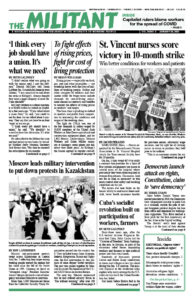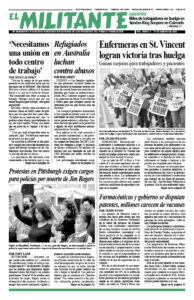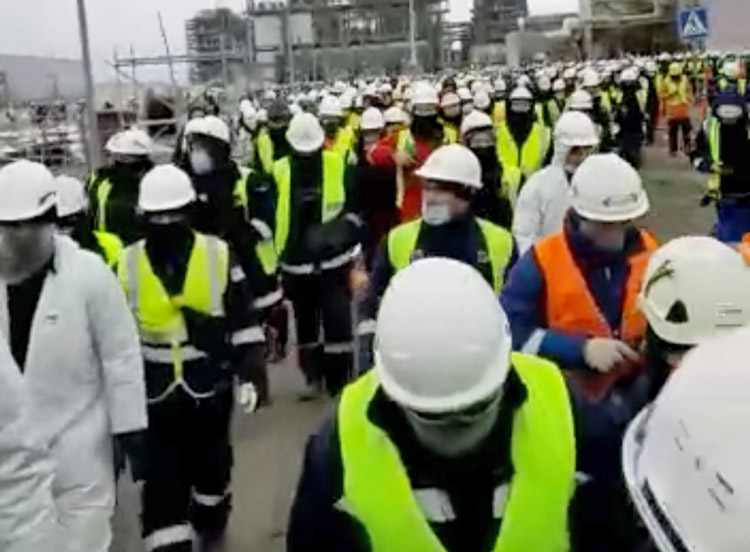Massive anti-government protests swept across Kazakhstan in Central Asia Jan. 2 reflecting deep anger among working people toward the regime that has ruled since the fall of the Soviet Union in 1991. Claiming he faced an “attempted coup,” President Kassym-Jomart Tokayev declared a state of emergency and asked Moscow to intervene.
More than 2,000 Moscow-led forces from the Collective Security Treaty Organization poured into the country Jan. 6. They included troops from Armenia, Belarus, Kyrgyzstan, Russia and Tajikistan, the first intervention by this alliance of some former Soviet republics. The pact was pulled together by Moscow to counter the expansion of the U.S.-led NATO forces in eastern Europe.
The next day, Tokayev announced that he had ordered security forces to “fire without warning” after over 160 people were killed, a majority in the country’s largest city, Almaty. Almost 10,000 had been detained. As Tokayev consolidated his grip on power he announced Jan. 11 that foreign forces will begin withdrawing.
Governments under former President Nursultan Nazarbayev, and his hand-picked successor Tokayev, trampled on rights to free speech and assembly, crushed opponents and banned their parties. Nazarbayev stepped aside for Tokayev in 2019, after three decades in power. Under both, social inequalities and joblessness rose.
On Jan. 8 Tokayev arrested Karim Massimov, Nazarbayev’s handpicked successor as the country’s intelligence chief, charging him and other security officials with “treason” for disobeying orders.
Solidarity action in U.S.
In New York’s Times Square Jan. 8 some 60 people, many of them young Kazakh immigrants, gathered behind a banner reading, “Stop dictatorship in Kazakhstan.” A group of Armenians joined with placards opposing the Armenian government’s part in the intervention.
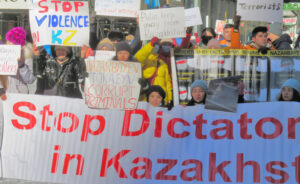
“All foreign troops out of Kazakhstan! We can solve the problems ourselves,” Gani Stambek from Free Kazakhs said as he convened the rally.
Russian President Vladimir Putin “wants to control the region,” Sherkan Suleimen, 24, from Los Angeles and also a leader of Free Kazakhs, told the Militant. “He’s worried if one post-Soviet regime falls then others will too.”
Protests in Kazakhstan began peacefully Jan. 2 in Zhanaozen, in the oil-rich western region of the country after the government doubled the price of liquefied petroleum gas overnight. An eight-month oil workers’ strike took place there in 2011. Workers continue to demand retribution for the deadly suppression of the strike by the Nazarbayev regime.
Despite the government rapidly rescinding the price increase, demonstrations continued to spread. As banned opposition parties joined in, actions reached a peak Jan. 5 in Almaty.
“Some police and soldiers refused to shoot and started joining the protests” prior to violence by provocative elements and police attacks, followed by Moscow’s intervention, Stambek told the Militant.
“The Nazarbayev family owns all the oil companies,” Suleimen told the Militant. Their grab for the country’s patrimony began following the privatizations of state enterprises after the breakup of the Soviet Union.
The two largest U.S. oil corporations, Chevron and ExxonMobil, have multibillion dollar investments in Kazakh oil and gas drilling companies — and close relations with the Nazarbayev family.
Oppressed by czars, Stalin
Kazakhs are a Muslim, Turkic-speaking people that for centuries were nomadic herders. They became subjected to national oppression by the Russian czars. Shortly after the triumph of the Bolshevik-led Russian Revolution in 1917, the region was ravaged by a civil war. The propertied classes, which tried to reimpose their rule, opposed Kazakh independence.
In 1920 Kazakhstan became an autonomous republic. Under V.I. Lenin, the revolutionary government championed the self-determination of oppressed peoples that made up the former czarist empire. For the first time Kazakhs had their own territory.
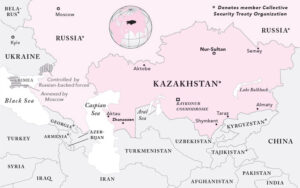
In the early 1920s, the revolutionary government worked with the nomadic people there. In the cities, Kazakh institutions of learning and culture were founded.
Kazakh Soviet leaders launched the Red Caravan expedition in 1922. It followed nomadic tribes across the steppes, establishing mobile outstations to educate about hygiene, domestic relations, labor efficiency, literacy and appreciation of culture. It offered medical aid, including vaccinations, as well as veterinary advice and better livestock breeding techniques.
Nomads who attended classes became voluntary emissaries for the Soviet system.
But a bloody counterrevolution carried out by petty-bourgeois bureaucratic layers headed by Joseph Stalin reversed these accomplishments in the late 1920s and ’30s. In Kazakhstan national leaders were brutally liquidated by Stalin’s henchmen.
From 1928 Stalin began the forced collectivization of peasant land, shattering the worker-peasant alliance on which the revolution was founded, and causing the deaths of millions across the Soviet Union. In Kazakhstan this involved the seizure of the nomads’ collectively owned herds, supposedly to end “nomadic feudalism,” and ending their migratory existence. Kazakhs slaughtered their animals rather than submit to Stalin’s dictates. In the famine of 1930-33, some 1.3 million Kazakhs died, a quarter of the republic’s population.
Once Stalin transformed the Soviet Union from a voluntary federation into its opposite, its breakup became inevitable. The police-state regime collapsed in 1991 and Kazakhstan became independent shortly afterwards. Nazarbayev then built his regime, enriching his family and supporters from the country’s patrimony on the backs of the toilers.
